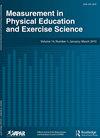Psychometric Properties of a French-Canadian Version of the Test of Gross Motor Development – Third Edition (TGMD-3): A Bifactor Structural Equation Modeling Approach
IF 1.9
4区 教育学
Q2 EDUCATION & EDUCATIONAL RESEARCH
Measurement in Physical Education and Exercise Science
Pub Date : 2021-07-14
DOI:10.1080/1091367X.2021.1946541
引用次数: 9
Abstract
ABSTRACT The objective was to assess the psychometric properties of a French-Canadian version of the third edition of the Test of Gross Motor Development (TGMD-3). Participants were 127 French-speaking Canadian children. Results supported the validity-reliability of a bifactor exploratory structural equation modeling representation of the TGMD-3. Additionally, results supported a lack of differential item functioning as a function of age, body mass index (BMI), physical activity/sport practice (PA/SP), and sex. Finally, latent mean differences showed that: (a) older children score lower on specific skills and higher on the global motor skills factor than younger children; (b) children with a higher BMI score lower on locomotor skills than children with a lower BMI; (c) children with higher weekly frequency of PA/SP score higher on the global motor skills factor than children with a lower weekly frequency of PA/SP; and (d) boys score higher on ball skills and lower locomotor skills than girls.法加版大肌肉运动发展测试的心理测量特性-第三版(TGMD-3):双因素结构方程建模方法
摘要:目的是评估第三版总运动发育测试(TGMD-3)的法加版本的心理测量特性。参与者是127名讲法语的加拿大儿童。结果支持TGMD-3的双因子探索性结构方程建模表示的有效性-可靠性。此外,研究结果支持缺乏与年龄、体重指数(BMI)、体育活动/运动实践(PA/SP)和性别相关的差异项目。最后,潜在平均差异表明:(a)年龄较大的儿童在特定技能方面得分较低,在整体运动技能因素方面得分较高;(b) BMI较高的儿童在运动技能方面得分低于BMI较低的儿童;(c) PA/SP周频率较高的儿童在整体运动技能因子上的得分高于PA/SP周频率较低的儿童;(d)男孩的球技得分高于女孩,运动技能得分低于女孩。
本文章由计算机程序翻译,如有差异,请以英文原文为准。
求助全文
约1分钟内获得全文
求助全文
来源期刊

Measurement in Physical Education and Exercise Science
Medicine-Orthopedics and Sports Medicine
CiteScore
4.20
自引率
33.30%
发文量
24
期刊介绍:
The scope of Measurement in Physical Education and Exercise Science (MPEES) covers original measurement research, special issues, and tutorials within six substantive disciplines of physical education and exercise science. Six of the seven sections of MPEES define the substantive disciplines within the purview of the original research to be published in the journal: Exercise Science, Physical Activity, Physical Education Pedagogy, Psychology, Research Methodology and Statistics, and Sport Management and Administration. The seventh section of MPEES, Tutorial and Teacher’s Toolbox, serves to provide an outlet for review and/or didactic manuscripts to be published in the journal. Special issues provide an avenue for a coherent set of manuscripts (e.g., four to five) to collectively focus in-depth on an important and timely measurement-related issue within the scope of MPEES. The primary aim of MPEES is to publish high-impact manuscripts, most of which will focus on original research, that fit within the scope of the journal.
 求助内容:
求助内容: 应助结果提醒方式:
应助结果提醒方式:


